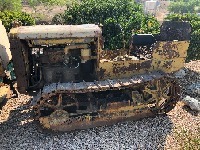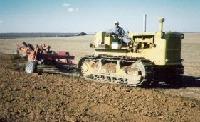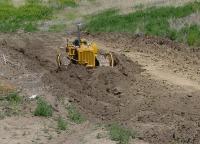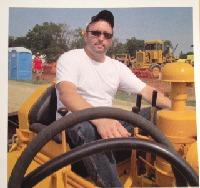-
Forum
-
Antique Caterpillar Machinery Owners Club
-
DISCUSSION
-
Comparing tractors: D2 5U VS. IH TD-6 62
Comparing tractors: D2 5U VS. IH TD-6 62
Less
More
-
Posts: 35
-
Thank you received: 23
-
1 year 10 months ago #244322
by USPatriot67
Hello all! Great thread here and I decided I would ante in. Before the sea of yellow came to my home my first crawler was a '47 TD6 bulldozer. I had bought this back in 2015, DOA and had it towed to my place with an expensive tow bill. This crawler belonged to the grandfather of the seller and was extensively used in a concrete and asphalt business. It has a fixed blade with no articulation and a couple of rippers that swing down and are used when operating the tractor in reverse. A carburetor rebuild and a couple of diesel fuel line replacements and I was able to run it on gasoline only. It turned out there was an issue with the diesel fuel injection pump and after a swap with a known good one, it ran on diesel as intended. I've used this crawler to move dirt and knock over small trees at my place. Fast forward to 2017 and I acquired another pair of '40s TD6s, orchards with fenders removed, from the son of a citrus grower near Ventura, California. Over time I resurrected the narrow gauge and the wide is currently used for spares. My introduction to Caterpillar started with the purchase of nine inoperative crawlers in various states from one of the last remaining farmers in the San Fernando Valley, California. His grandfather stated farming there in the 1920's and as of 2019 there was quite the collection of farm equipment the grandson, now in his mid 80s was trying to sell off. Being a red tractor guy at the time, I just wanted to buy a 1937 IH T35 (6 cylinder IH Red Diamond truck engine powered) he had on hand. The yellows included a '48 D4-6U parts machine, a '29 TEN (named Tracy), two parts 22s and four "potential runner" 22s. The earliest being THE LAST '34 22 produced (engine only) others as late as 1937. After consulting a friend of mine, he suggested buying all nine crawlers and would cover half the cost. He had done some research online and thought we could make some money on them. He would make seats and sheet metal and I would do the rest. I fronted the money and took the lot to his property. There is a reason why a farmer parks tractors. The four 22 "potential runners" as well as the TEN had a major failure of some sort whether it be engine, clutch, or transmission related. A few of the 22's had mixed matched engines and transmissions. My partner never followed through on his end and these all ended up at my place. As of now, after resurrecting and selling multiple yellows I'm down to my running keeper TEN (Tracy) and THE LAST '34 22. I appreciate if you made to the end of my ranting on my origins into the vintage CAT world, I got off topic here. My final point: I love my TD6 collection when it comes to maintenance. Steering and main clutch replacements, brake bands haven't been terrible issues. All are performed in chassis without pulling tracks/chains or final drives. Granted, I don't put hundreds of hours on either TD6 so I haven't experienced the cylinder head issues like others have stated as of yet. I agree that a lot of parts for these are falling into an unobtanium category as opposed to the Caterpillar equipment but there are entities out there that carry good, affordable used parts. My shout out to FP Smith. No shame in a variety of colors when it comes to old equipment. Stay well and Happy belated New Year!
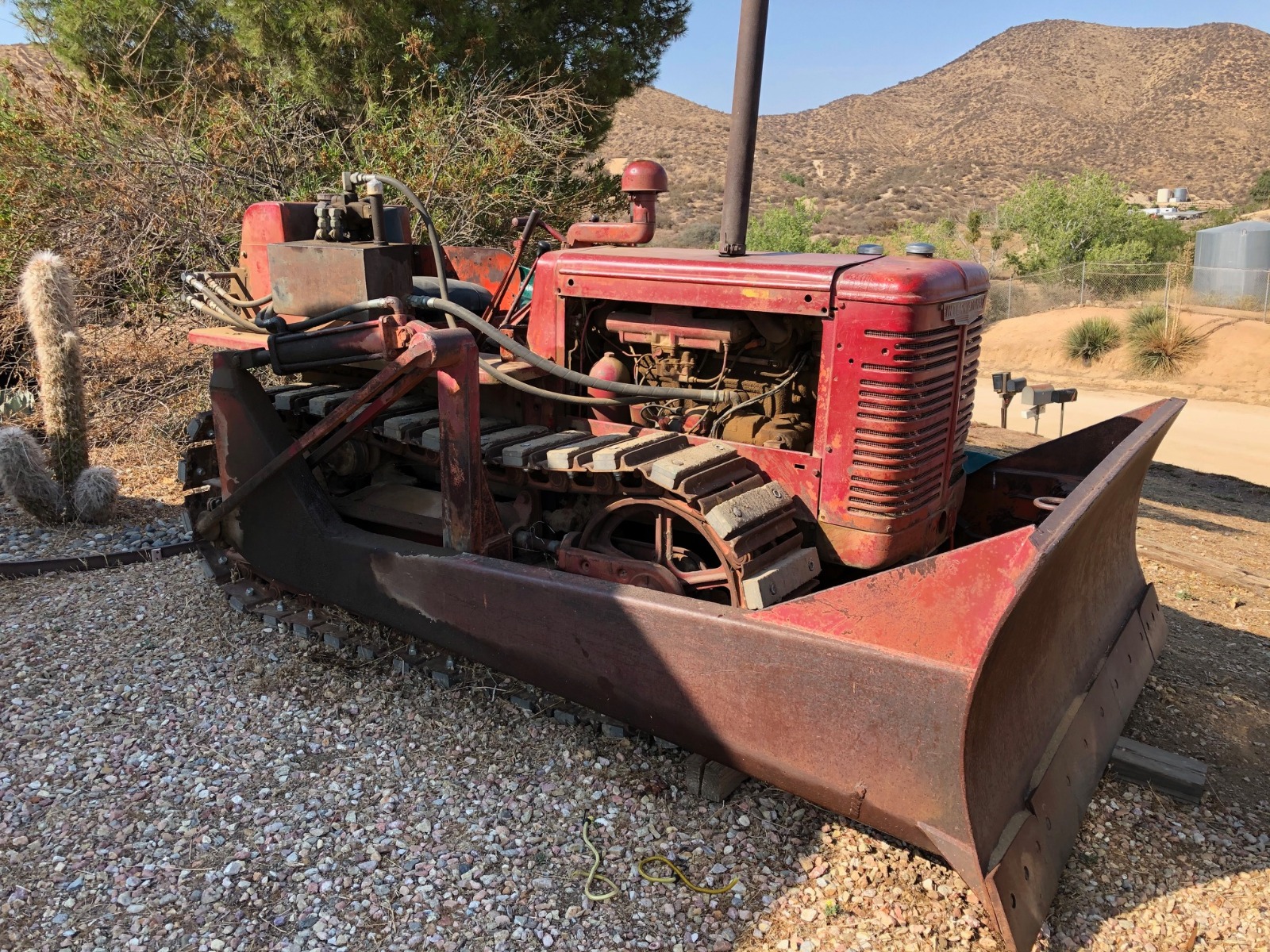

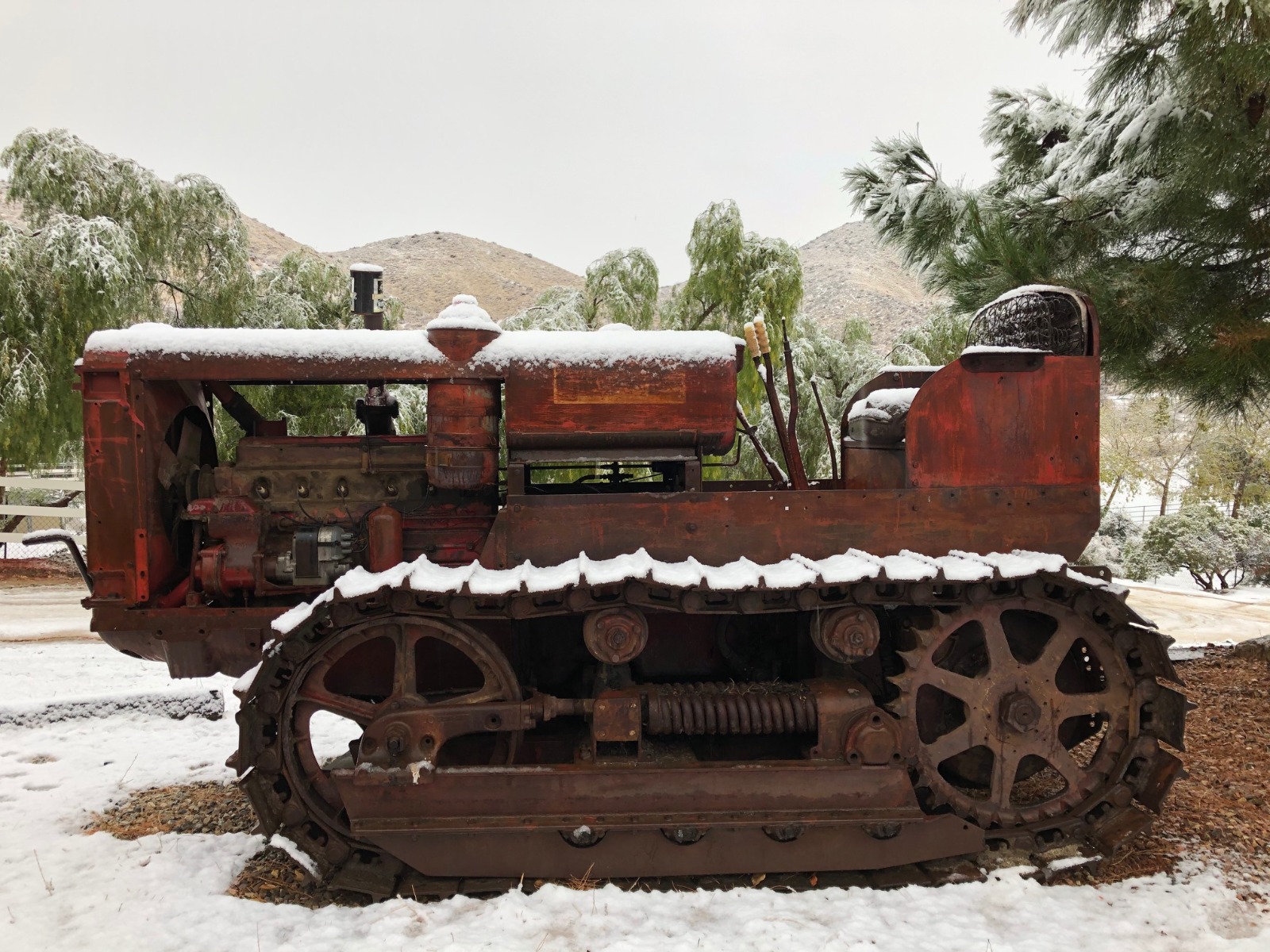
Please Log in or Create an account to join the conversation.
Less
More
-
Posts: 1287
-
Thank you received: 405
-
1 year 10 months ago #244323
by D4Jim
Great post Patriot! Out here on the great plains a lot of farmers used WD-6's, WD-9's and super versions. I cannot remember any problems with heads cracking that seem to have given the IH Diesels a bad name. With your knowledge of the IH Crawlers do you know of major problems with the heads cracking? I often hear it mentioned but in the real world I cannot think of any heads failing in our tractors or the neighbors and that would include probably 40 tractors or more..
ACMOC Member 27 years
D47U 1950 #10164
Cat 112 1949 #3U1457
Cat 40 Scraper #1W-5494
Please Log in or Create an account to join the conversation.
Less
More
-
Posts: 1818
-
Thank you received: 321
-
1 year 10 months ago #244328
by Ray54
Not trying to be mean about it but I can take you to lots of IH crawlers ran when parked.........................................just loses a little water out all the time. And the famous .........................a head gasket will fix it. Near 99% of them have cracked heads. As I stated at the beginning of this discussion with just bit of luck and following known practices of idling 10 minutes or more before shut down the heads can be made to last the life of the rest of the engine. Just that it seems it just is not followed all the time. Maybe all this is worse here with the higher temps we deal with much of the year. My take is IH acknowledged it had a problem by the fact they made many miner changes to heads on the gas start diesels and then bigger changes of the jet heads and the extra overflow tank up on top of the hood.
So if you find a good running IH if you treat it right you could get lots of use out of it. But I will never buy the story a head gasket is all it takes to fix one blowing water. But you will never be looking for heavy duty pulling gear to get finals, sprockets, or transmissions apart, like in the D7 posted yesterday. So use it if you have it. If you don't steer clutches can rust up just like all the others.
Please Log in or Create an account to join the conversation.
Less
More
-
Posts: 329
-
Thank you received: 89
-
1 year 10 months ago #244329
by gary in CA
To help stop the head cracking IH came out with a additional radiator tank that sat on top of the hood.The TD15 that we had,had one.
It was added later in the field.Picture off of Google
Eventually all the IH crawlers we had,TD6,TD9,TD14,TD15,TD18 disappeared but the TD9. Over time three D7s,Three HD11s,a D6C and the TD9 stayed
All working 2,600 acres of open ground.Fun times
Please Log in or Create an account to join the conversation.
Less
More
-
Posts: 6638
-
Thank you received: 929
-
1 year 10 months ago - 1 year 10 months ago #244330
by Deas Plant.
Hi, Folks.
As I have been told, the extra chamber in the head to lower compression for starting on gas made for a thin wall between that chamber and the water galleries and this is where the heads used to crack. Apparently, even the so-called 'jet heads' did not completely cure the problem and nor did the header tank.
I have been told by a man who was a dealer for them for about 20 years that it was pretty much a 'MUST' to idle them down for 10 minutes or more to avoid the problem if they had been working at all hard. Didn't seem to be a problem if they had only been running light but was apparently still a good idea to idle them down of they had gotten to full operating temperature to even out the heat throughout the cooling system and the block and head.
Just my 0.02.
You have a wonderful day. Best wishes. Deas Plant.
Last edit: 1 year 10 months ago by
Deas Plant.. Reason: Added info.
Please Log in or Create an account to join the conversation.
Less
More
-
Posts: 1242
-
Thank you received: 125
-
1 year 10 months ago #244335
by Sasquatch
My great grandfather was a blade operator for the county for a long time, he ran Austin-Western graders that had IH gas start diesels for power. He always had cylinder head cracking problems with them, finally was told by an IH mechanic to always let the engine cool down before shutting off (they typically were started in the morning and not shut off until end of shift) but unfortunately the advice wasn’t taken seriously and the problem continued to persist. Fast forward a couple decades and my dad bought an IH UD-18 power unit for running his sawmill - dad was a career mechanic and already had a good understanding of their head cracking issues. Not only would he idle the engine for 10-15 minutes at the end of the day while the mill was being cleaned out and re-greased, but he’d also flip it back to gasoline mode and let it run at lower compression until the carburetor bowl ran dry, finally stopping the engine. One last flip of the switch-over lever to close the combustion chamber valves to let them cool at the same rate as everything else finally completed the process - I’ve been around that engine since I was 3 years old and it’s never cracked a head with the careful shut-downs. I think the IH gas starts are a lot like Cat’s ponies in that if a few simple steps are followed EVERY TIME (like clean, full oil in the ponies and always shutting them off by running the gas out) then a lot of trouble will be avoided.
Please Log in or Create an account to join the conversation.
Less
More
-
Posts: 329
-
Thank you received: 89
-
1 year 10 months ago #244336
by gary in CA
Sasquatch, we always put our IH crawlers back on gas at shutdown after cooling down.Never had a cracked head that I recall and they always seemed to start easier the next day
Thanks for the reminder.Been a long time ago
Please Log in or Create an account to join the conversation.
Less
More
-
Posts: 1287
-
Thank you received: 405
-
1 year 10 months ago #244342
by D4Jim
It may have been pure dumb luck.....
Interesting about the cooling down period to reduce head cracking in the IH diesels. On our farm and I assume most others around here we had a natural cooling down period for the tractors after working in the field as it was usually some distance to the farm and the fuel barrel. During that time the engine would have naturally cooled from the reduced load for the 10 to 20 minute drive back to the farmstead. Could have been pure dumb luck!! We rarely took fuel to the tractors but rather took the tractor to the fuel tank.
ACMOC Member 27 years
D47U 1950 #10164
Cat 112 1949 #3U1457
Cat 40 Scraper #1W-5494
Please Log in or Create an account to join the conversation.
Less
More
-
Posts: 35
-
Thank you received: 23
-
1 year 10 months ago #244343
by USPatriot67
D4Jim, thanks for the acknowledgement! Unfortunately due to my limited operational time on my TD6s, I cannot confirm nor deny and potential cylinder head issues. My '40 wide track cannibalization crawler had the cylinder head removed when I bought the orchard pair. I haven't performed any NDT on that cylinder head to verify issues as the pistons and cylinders were exposed to the elements for 20+ years and the engine is locked up. After running my TDs I do what Sasquatch had mentioned in his post; I switch back to the gasoline mode, allow the engine to idle for at least five minutes, shut the fuel off at the little gasoline tank that feeds the starting carb, then allow the engine to stall. Subsequently, I move the decompression lever forward to shut the starter valves as not to warp them.
Please Log in or Create an account to join the conversation.
Less
More
-
Posts: 713
-
Thank you received: 108
-
1 year 10 months ago #244355
by GrantJ
Juiceman, if you want a few spare parts for the TD6, i can bring them to the meeting on the 14th. Barring the Sacramento Valley not becoming a lake by then.
Radiator and shell, intake manifold and carb, I think a skid plate, I have a few other parts that I will have to look at to remember what they are. I cant stand to scrap parts, so I end up with too much stuff. Glad to pass it on. Grant.
Please Log in or Create an account to join the conversation.
-
Forum
-
Antique Caterpillar Machinery Owners Club
-
DISCUSSION
-
Comparing tractors: D2 5U VS. IH TD-6 62
Time to create page: 0.207 seconds

